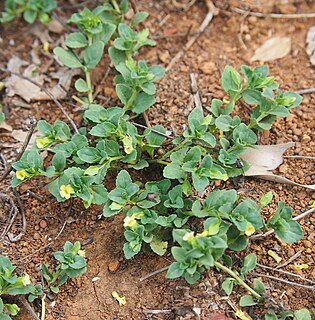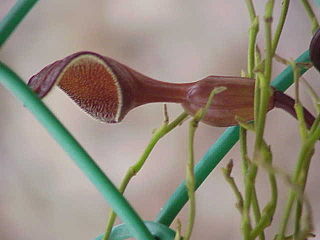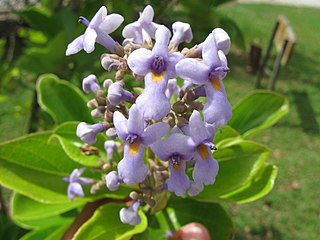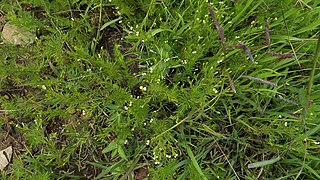Acidoton is a genus of plant of the family Euphorbiaceae first described as a genus in 1788. It is native to the Greater Antilles, Central America, and tropical South America.

Dalechampia dioscoreifolia is a species of plant in the family Euphorbiaceae first described in 1841. It is native to Central America and northern and western South America.

Brunellia is a genus of trees. They are distributed in the mountainous regions of southern Mexico, Central America, West Indies, and South America. Brunellia is the only genus in the family Brunelliaceae. As of 2001 there were about 54 species.
Metalepis is a genus of plant in family Apocynaceae first described as a genus in 1866. It is native to northern South America, Central America, Mexico, Florida, and the West Indies.
- Metalepis albifloraUrb. - Colombia, Ecuador, Fr Guiana, N Brazil, West Indies
- Metalepis cubensis(A. Rich.) Griseb. - Florida, Cuba, Belize, Veracruz in Mexico
- Metalepis gentryiMorillo - Ecuador
- Metalepis haughtii(Woodson) Morillo - Ecuador
- Metalepis peraffinis(Woodson) Morillo - S Mexico, Central America, Colombia
- Metalepis prevostiaeMorillo - French Guiana, Panama

Stenospermation is a genus of plant in family Araceae native to South America and Central America.

Teuscheria is a genus of orchids native to southern Mexico, Central America and northern South America. The genus is named for Henry Teuscher, an award-winning landscape artist and horticulturalist.

Sievekingia is a genus of orchid, comprising 20 species found in Central and South America, from Nicaragua east to the Guianas and south to Bolivia.

Aechmea dactylina is a plant species in the genus Aechmea. This species is native to Costa Rica, Nicaragua, Panama, Colombia and Ecuador.

Pitcairnia atrorubens is a species of flowering plant in Bromeliaceae family. It is native to Costa Rica, Panama, Honduras, Guatemala, Colombia, and western Mexico as far north as Nayarit.

Cischweinfia is a genus of flowering plants from the orchid family, Orchidaceae. It was named after Harvard orchidologist Charles Schweinfurth. It has eleven currently recognized species, all native to Central America and northwestern South America.

Pterichis is a genus of flowering plants from the orchid family, Orchidaceae. It is native to South America, Central America and Jamaica.

Sarcoglottis is a genus of flowering plants from the orchid family, Orchidaceae. It is widespread across much of Latin America from Mexico to Argentina, with one species extending northward into Trinidad and the Windward Islands.

Mecardonia (axilflower) is a genus of herbaceous plants in the family Plantaginaceae. 31 species have been described, of which 12 are accepted. Its distribution is predominantly in South America, and South East United States, including Florida and Alabama but may be found as far north as Virginia. (see map) Five species are found in Argentina and three in the US.

Aristolochia maxima is a plant species native to Central and South America, naturalized in southern Florida. Common names include Florida Dutchman's-pipe (US), canastilla (Guatemala), guaco, and tecolotillo (Mexico). In Florida, it grows in hammocks in the Everglades at elevations below 50 m.
Diastatea is a genus of plants native to Latin America, mostly in Mexico and Central America but with one species extending southward along the Andes to Argentina.
- Diastatea costaricensisMcVaugh - Guatemala, Honduras, Nicaragua, Costa Rica
- Diastatea expansaMcVaugh - central Mexico
- Diastatea ghiesbreghtii(Kuntze) E.Wimm - southwestern Mexico
- Diastatea micrantha(Kunth) McVaugh - widespread from central Mexico to the Jujuy region of northern Argentina
- Diastatea tenera(A.Gray) McVaugh - southern Mexico and Guatemala
- Diastatea virgataScheidw. - southern Mexico

Cornutia is a genus of plants in the family Lamiaceae, first described in 1753. It is native to tropical parts of the Western Hemisphere: southern Mexico, Central America, West Indies, northern South America.
- Cornutia australisMoldenke - Ecuador, Brazil
- Cornutia coerulea(Jacq.) Moldenke - Jamaica
- Cornutia jamaicensisMoldenke - Jamaica
- Cornutia obovataUrb. - Puerto Rico
- Cornutia odorata(Poepp.) Schauer - Venezuela, Colombia, Ecuador, Peru
- Cornutia pubescensC.F.Gaertn. - French Guiana
- Cornutia pyramidataL. - southern Mexico, Central America, West Indies, Suriname, Venezuela, Colombia, Ecuador, Peru
- Cornutia thyrsoideaBanks ex Moldenke - Jamaica

Ludovia is a genus of plants first described as a genus in 1861. All the known species are native to Central and South America.

Fischeria is a plant genus in the family Apocynaceae, first described as a genus in 1813. It is native to South America, Central America, southern Mexico, and the West Indies.

Tagetes filifolia is a New World species of marigolds in the sunflower family. It is widespread across much of Latin America from northern Mexico to Argentina. Common name is Irish lace despite the fact that the plant does not grow in Ireland.

Dr. Charlotte M. Taylor is a botanist and professor specialising in taxonomy and conservation. She works with the large plant family Rubiaceae, particularly found in the American tropics and in the tribes Palicoureeae and Psychotrieae. This plant family is an economically important group, as it includes plant species used to make coffee and quinine. Taylor also conducts work related to the floristics of Rubiaceae and morphological radiations of the group. Taylor has collected plant samples from many countries across the globe, including Chile, Colombia, Costa Rica, Panama, and the United States of America, and has named many new species known to science from these regions. As of 2015, Taylor has authored 278 land plant species' names, the seventh-highest number of such names authored by any female scientist.
















